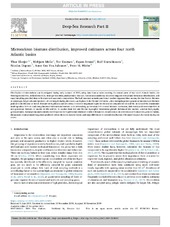| dc.contributor.author | Klevjer, Thor A. | |
| dc.contributor.author | Melle, Webjørn Raunsgård | |
| dc.contributor.author | Knutsen, Tor | |
| dc.contributor.author | Strand, Espen | |
| dc.contributor.author | Korneliussen, Rolf | |
| dc.contributor.author | Dupont, Nicolas | |
| dc.contributor.author | Salvanes, Anne Gro Vea | |
| dc.contributor.author | Wiebe, Peter H. | |
| dc.date.accessioned | 2020-08-19T08:11:00Z | |
| dc.date.available | 2020-08-19T08:11:00Z | |
| dc.date.issued | 2019 | |
| dc.Published | Klevjer TA, Melle WR, Knutsen T, Strand ES, Korneliussen R, Dupont N, Salvanes AGV, Wiebe PH. Micronekton biomass distribution, improved estimates across four north Atlantic basins. Deep-sea research. Part II, Topical studies in oceanography. 2019 | eng |
| dc.identifier.issn | 0967-0645 | en_US |
| dc.identifier.issn | 1879-0100 | en_US |
| dc.identifier.uri | https://hdl.handle.net/1956/23853 | |
| dc.description.abstract | Distribution of micronekton was investigated during early summer of 2013, using data from a cruise covering the central parts of four north Atlantic basins, the Norwegian Sea (NS), Iceland Sea (ICS), Irminger Sea (IRS), and Labrador Sea (LS). Continuous underway acoustics mapped vertical and horizontal distributions, and trawl sampling provided data on biomass and taxonomic composition. The hull mounted acoustics and trawl catches suggested that, among the four basins, biomass of epipelagic, larger nektonic species (>20 cm length) during the cruise was highest in the NS and ICS basins, while mesopelagic non-gelatinous micronekton biomass peaked in the IRS and LS basins. Biomass of Scyphozoa was also about 1 order of magnitude higher in IRS and LS compared to ICS and NS. In ICS and NS, crustaceans made up about 50% of total non-gelatinous micronekton biomass, with fish making up less than 20% of total biomass. In contrast, fish constituted more than 60% of non-gelatinous biomass of catches in IRS and LS. In catches from ICS and NS the myctophid Benthosema glaciale dominated the catches, whereas bathylagids, gonostomatids, barracudinas and stomiids contributed to the high biomass densities of fish in IRS and LS. In addition to the differences in biomass between the basins, the acoustic measurements suggested gradients within the north-eastern basins, and large differences in vertical distribution of biomass between the basins during the cruise. | en_US |
| dc.language.iso | eng | eng |
| dc.publisher | Elsevier | en_US |
| dc.rights | Attribution-Non Commercial-No Derivatives CC BY-NC-ND | eng |
| dc.rights.uri | http://creativecommons.org/licenses/by-nc-nd/4.0/ | eng |
| dc.title | Micronekton biomass distribution, improved estimates across four north Atlantic basins | en_US |
| dc.type | Peer reviewed | |
| dc.type | Journal article | |
| dc.date.updated | 2020-01-28T08:54:57Z | |
| dc.description.version | publishedVersion | en_US |
| dc.rights.holder | Copyright 2019 The Authors | en_US |
| dc.identifier.doi | https://doi.org/10.1016/j.dsr2.2019.104691 | |
| dc.identifier.cristin | 1771525 | |
| dc.source.journal | Deep-sea research. Part II, Topical studies in oceanography | |
| dc.relation.project | Norges forskningsråd: 203871 | |
| dc.relation.project | EC/FP7: 264933 | |

